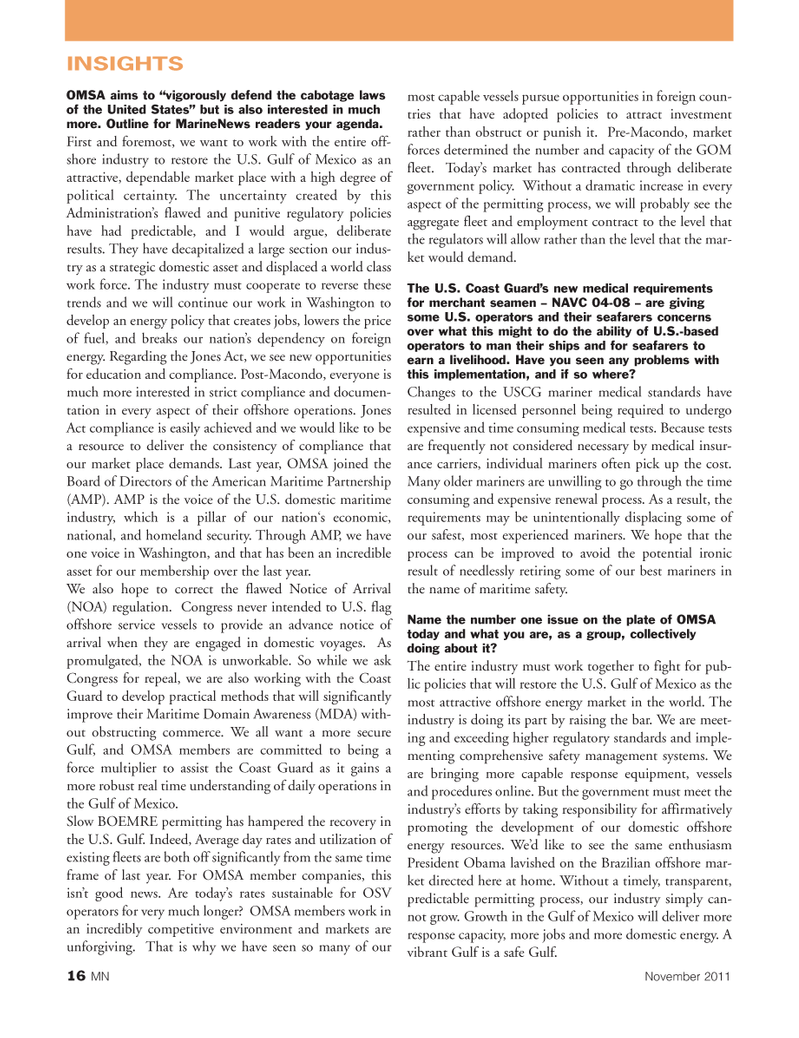
Page 16: of Marine News Magazine (November 2011)
Workboat Annual
Read this page in Pdf, Flash or Html5 edition of November 2011 Marine News Magazine
16MNNovember 2011INSIGHTSOMSA aims to ?vigorously defend the cabotage laws of the United States? but is also interested in much more. Outline for MarineNews readers your agenda. First and foremost, we want to work with the entire off- shore industry to restore the U.S. Gulf of Mexico as an attractive, dependable market place with a high degree of political certainty. The uncertainty created by this Administration?s flawed and punitive regulatory policies have had predictable, and I would argue, deliberate results. They have decapitalized a large section our indus- try as a strategic domestic asset and displaced a world class work force. The industry must cooperate to reverse these trends and we will continue our work in Washington to develop an energy policy that creates jobs, lowers the price of fuel, and breaks our nation?s dependency on foreign energy. Regarding the Jones Act, we see new opportunities for education and compliance. Post-Macondo, everyone is much more interested in strict compliance and documen- tation in every aspect of their offshore operations. Jones Act compliance is easily achieved and we would like to be a resource to deliver the consistency of compliance that our market place demands. Last year, OMSA joined the Board of Directors of the American Maritime Partnership (AMP). AMP is the voice of the U.S. domestic maritime industry, which is a pillar of our nation?s economic, national, and homeland security. Through AMP, we have one voice in Washington, and that has been an incredible asset for our membership over the last year. We also hope to correct the flawed Notice of Arrival (NOA) regulation. Congress never intended to U.S. flag offshore service vessels to provide an advance notice of arrival when they are engaged in domestic voyages. As promulgated, the NOA is unworkable. So while we ask Congress for repeal, we are also working with the Coast Guard to develop practical methods that will significantly improve their Maritime Domain Awareness (MDA) with- out obstructing commerce. We all want a more secure Gulf, and OMSA members are committed to being a force multiplier to assist the Coast Guard as it gains a more robust real time understanding of daily operations in the Gulf of Mexico. Slow BOEMRE permitting has hampered the recovery in the U.S. Gulf. Indeed, Average day rates and utilization of existing fleets are both off significantly from the same time frame of last year. For OMSA member companies, this isn?t good news. Are today?s rates sustainable for OSV operators for very much longer? OMSA members work in an incredibly competitive environment and markets are unforgiving. That is why we have seen so many of our most capable vessels pursue opportunities in foreign coun- tries that have adopted policies to attract investment rather than obstruct or punish it. Pre-Macondo, market forces determined the number and capacity of the GOM fleet. Today?s market has contracted through deliberate government policy. Without a dramatic increase in every aspect of the permitting process, we will probably see the aggregate fleet and employment contract to the level that the regulators will allow rather than the level that the mar- ket would demand. The U.S. Coast Guard?s new medical requirements for merchant seamen ? NAVC 04-08 ? are giving some U.S. operators and their seafarers concerns over what this might to do the ability of U.S.-basedoperators to man their ships and for seafarers to earn a livelihood. Have you seen any problems with this implementation, and if so where? Changes to the USCG mariner medical standards have resulted in licensed personnel being required to undergo expensive and time consuming medical tests. Because tests are frequently not considered necessary by medical insur- ance carriers, individual mariners often pick up the cost.Many older mariners are unwilling to go through the time consuming and expensive renewal process. As a result, the requirements may be unintentionally displacing some of our safest, most experienced mariners. We hope that the process can be improved to avoid the potential ironic result of needlessly retiring some of our best mariners in the name of maritime safety. Name the number one issue on the plate of OMSAtoday and what you are, as a group, collectively doing about it?The entire industry must work together to fight for pub- lic policies that will restore the U.S. Gulf of Mexico as the most attractive offshore energy market in the world. The industry is doing its part by raising the bar. We are meet- ing and exceeding higher regulatory standards and imple- menting comprehensive safety management systems. We are bringing more capable response equipment, vessels and procedures online. But the government must meet the industry?s efforts by taking responsibility for affirmatively promoting the development of our domestic offshore energy resources. We?d like to see the same enthusiasm President Obama lavished on the Brazilian offshore mar- ket directed here at home. Without a timely, transparent, predictable permitting process, our industry simply can- not grow. Growth in the Gulf of Mexico will deliver more response capacity, more jobs and more domestic energy. A vibrant Gulf is a safe Gulf. MN#11 (1-17):MN 2011 Layouts 10/28/2011 3:26 PM Page 16

 15
15

 17
17
